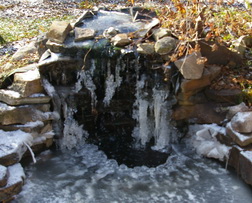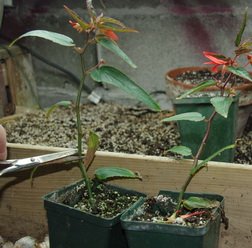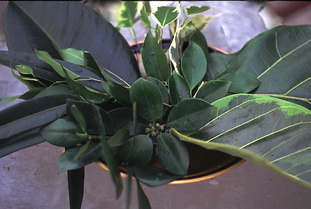

|
Well my strange picture from the last issue of “Dallying” confounded most of you but here is a great answer from Kevin: “That picture you referred to in your most recent issue looks to be a dahlia you over-wintered last fall but forgot to plant this spring. It was probably sitting in a cool, dark very safe place. Am I on the right track? “  The ponds have frozen completely in our very early arrival of winter and have now thawed out again. I need to get the pump turned off and the air bubblers in and working. Most of the rest of the pond overwintering preparation I had already managed to do but I like to see the waterfall running as long as possible. It’s really quite pretty as the ice makes some delightful formations down the waterfall. I need to replace a few of the pond light bulbs because the icy waterfall is even better when lit up. The trick is to know just when winter is here to stay so that I can shut the system down and have it drain.
The ponds have frozen completely in our very early arrival of winter and have now thawed out again. I need to get the pump turned off and the air bubblers in and working. Most of the rest of the pond overwintering preparation I had already managed to do but I like to see the waterfall running as long as possible. It’s really quite pretty as the ice makes some delightful formations down the waterfall. I need to replace a few of the pond light bulbs because the icy waterfall is even better when lit up. The trick is to know just when winter is here to stay so that I can shut the system down and have it drain.Winter wasn’t the only thing that came early this year. My first seed catalogue is already here. They usually don’t arrive until late Dec. Are early seed catalogues an indicator of a long winter just like the fuzzy coats on the caterpillars or whatever the old farmer’s almanac is using as indicators this year? Maybe that also explains why the Cymbidium Orchids are blooming so early this year. Some of the bloom stalks are now over 30 cm long and we usually don’t see anything at all until well into January. It’s going to be delightful to have them brightening up the solarium most of the winter.  The many cuttings from the Bonfire, (I think I called it Wildfire last issue,) Begonia have rooted well and are growing under the lights in the basement. They are growing very tall and I’m going to have to start cutting a few of them back to see if I can get them to branch out and become nice short thickly branched plants. I plan to the do the garage wall planters with them next year and that will require about 60 plants. The cuttings I made when I cut them back are the first failures that I have had in a long time. I think that I was too busy and did not keep them watered well enough. I try to lightly sprinkle new cuttings at least twice a day until it’s obvious that they have settled in. Oops! The plants that I cut back the hardest are not yet showing much sign of breaking out into thick bushes but I’m sure they will soon.
The many cuttings from the Bonfire, (I think I called it Wildfire last issue,) Begonia have rooted well and are growing under the lights in the basement. They are growing very tall and I’m going to have to start cutting a few of them back to see if I can get them to branch out and become nice short thickly branched plants. I plan to the do the garage wall planters with them next year and that will require about 60 plants. The cuttings I made when I cut them back are the first failures that I have had in a long time. I think that I was too busy and did not keep them watered well enough. I try to lightly sprinkle new cuttings at least twice a day until it’s obvious that they have settled in. Oops! The plants that I cut back the hardest are not yet showing much sign of breaking out into thick bushes but I’m sure they will soon. It’s time to appreciate our regular houseplants a little more as we run out of greenery and soft soil outside. There are a wide variety of plants that we keep in our houses and I hope to highlight many of them over the winter. One group that is quite diverse and fascinating is the genus, (fancy word for plants who are cousins,) Ficus. They include the edible Fig and many great houseplants. The large weeping figs in every shopping mall and airport belong to this group as well as a delightful trialing species, Ficus pumila. All related to each other by their unique flowering habit.
It’s time to appreciate our regular houseplants a little more as we run out of greenery and soft soil outside. There are a wide variety of plants that we keep in our houses and I hope to highlight many of them over the winter. One group that is quite diverse and fascinating is the genus, (fancy word for plants who are cousins,) Ficus. They include the edible Fig and many great houseplants. The large weeping figs in every shopping mall and airport belong to this group as well as a delightful trialing species, Ficus pumila. All related to each other by their unique flowering habit.Questions My newsletter subscribers get to ask me questions. Just ‘reply’ to the email newsletter. It is always interesting to read the questions; mostly to see if I actually can answer them or if I have to wade into the textbooks to research the answers. If that happens then we all learn something. Shirley Asks? is it too late to pot up for forcing, the bulbs I never did get around to planting outdoors? Ken Answers! Absolutely not. They will be ready to bloom a little later in the spring and it can sometimes be a bit of a challenge to find a cool enough spot for them in early spring. If you try you will have flowers otherwise you have a bag of compost. 111 Trent St. W. Whitby ON L1N1L9 |
